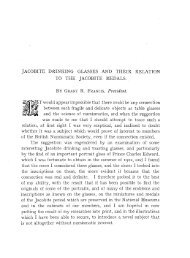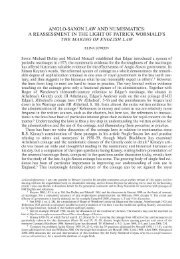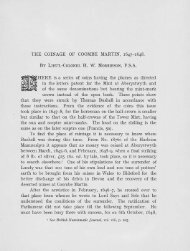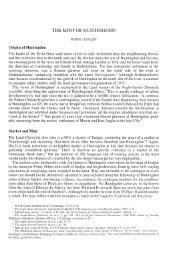MONEYERS IN THE 1130 PIPE ROLL
MONEYERS IN THE 1130 PIPE ROLL
MONEYERS IN THE 1130 PIPE ROLL
Create successful ePaper yourself
Turn your PDF publications into a flip-book with our unique Google optimized e-Paper software.
4 <strong>MONEYERS</strong> <strong>IN</strong> <strong>THE</strong> <strong>1130</strong> <strong>PIPE</strong> <strong>ROLL</strong><br />
Henry I, but there was a Spracelinc at Winchester in the 1080s and 1090s and a Sperling or<br />
Sperlings at Hastings under William II and at London under William II and Henry I. Since<br />
Spracheling is bracketed in the roll with Algar, an undoubted London moneyer of Henry I,<br />
in respect of a coinage offence, there are good grounds for following Andrew in identifying<br />
him with the London moneyer Sperling. 24 Although it would imply a minting career of up to<br />
forty years, it is even conceivable that he was the same man not only as the Hastings Sperling,<br />
but also as the Winchester Spracelinc, since Winchester had frequently exchanged moneyers<br />
with the Sussex mints before the Conquest. 25 Sperling was a London alderman and Algar a<br />
canon of St Paul's. 26 Godwin Quachehand (is it too fanciful to interpret his byname as<br />
referring to the loss of his right hand by mutilation?) is probably to be identified as the<br />
GODP<strong>IN</strong>E GV on a unique coin, of illegible mint, of type XV, since G is sometimes used for Q<br />
on late Saxon coinage, and there was a Godwine at London in type XIV. 27<br />
Brand's entry provides what appears to be the only direct reference to the Winchester<br />
assize. He accounted for £20 'ne esset disfactus cum aliis monetariis'. He had paid £4 into<br />
the exchequer in 1129/30 and still owed £16. If he had been paying off his debt at the same<br />
annual rate since 1124/5, his original fine would have been £40. Brand was a prolific<br />
moneyer at Chichester up to type XIII, but he is known from only a single coin of type<br />
XIV. 28 Chichester, like all the other Sussex mints, was closed during type XV but there is a<br />
coin of Stephen type I of this mint with a short moneyer's name ending in D, 29 which seems<br />
to suggest that Brand briefly returned to office sometime after 1135. One wonders whether<br />
Brand can have been alone in being allowed to pay a fine by way of penalty instead of being<br />
mutilated with the other moneyers. Given the attractions of revenue to the crown, it could<br />
have been an option offered to quite a number of moneyers adjudged guilty provided that<br />
they could demonstrate the prospect of being able to pay. The Pipe Roll of 1124/5 would<br />
no doubt be an illuminating document on this score.<br />
Although not referring to the payment of fines in lieu of mutilation, many of the other<br />
entries relating to coinage offences are likely to date back to the Winchester assize. While<br />
that was very probably not the first or last occasion in the 1120s on which a moneyer was<br />
fined or otherwise punished, it was clearly much the most drastic and comprehensive, and<br />
presumably lies behind an entry such as that under Pembroke. There the moneyer<br />
Gillopatric accounted for £4 'pro foris(facto) veteris monete'. He had paid 40s. in 1129/30<br />
and still owed 40s. If paid at £2 per annum since 1124/5, his original fine would have been<br />
£14. Gillopatric's coins are known between type X of Henry and type I of Stephen, and are<br />
all very rare, as befits the output of a very small county mint where he was the only<br />
moneyer. The nature of his wrongdoing in relation to the old coinage is not stated, but if it<br />
was similar to Brand's the difference in the amount of their fines could have been due to<br />
the fact that the scale of Gillopatric's coinage was less.<br />
Algar and Spracheling, though not described as moneyers, are entered under London as<br />
owing 10 marks for an offence of false pennies ('pro foris(facto) falsorum denariorum'),<br />
which sounds like something close to forgery. Algar was a London moneyer in all types<br />
from X to XIV of Henry I, and several earlier. Although not known from official coins of<br />
type XV, he reappears in type I of Stephen. Andrew suggested that he may not have<br />
learned the lesson from his punishment, since there are some plated forgeries combining<br />
an obverse of Stephen with a reverse of Henry's type XV that appears to carry his name. 30<br />
24 PR p. 148; Andrew, pp. 275 and 282-4. Surprisingly,<br />
Brooke (BMC p. exlv) saw 'no reason to suppose' that Algar<br />
and Spracheling were moneyers. Dr Conte advises me that<br />
Sperling is now also known for Northampton in type X from<br />
a coin in the recent Mansfield-Woodhouse find.<br />
25 I. Stewart, 'The Sussex mints and their moneyers', in<br />
The South Saxons, edited by P. Brandon (1978), pp. 89-137.<br />
26 Nightingale, pp. 41, 43 and 48.<br />
27 PR p. 146; Andrew, pp. 282-3 and 300; again Brooke<br />
(BMC p. cxlv, n. 2) is sceptical.<br />
28 BMC 120.<br />
29 Glendining, 14 Oct. 1985, lot 50.<br />
30 Andrew, p. 283; SCBI Mack, no. 1582.



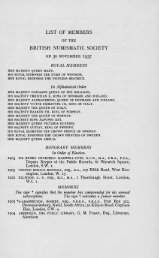

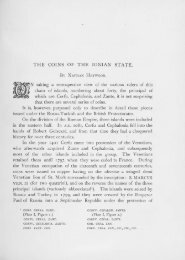
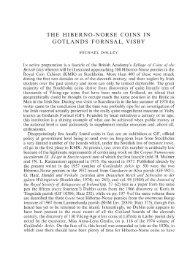
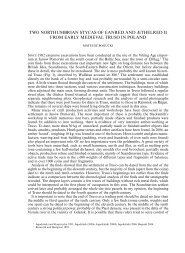

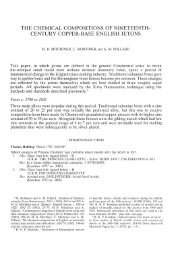
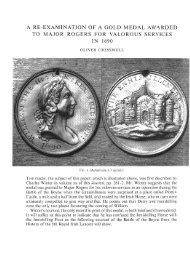
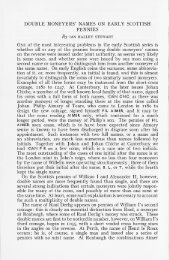
![Two Anglo-Saxon notes: [1] A Cnut die-link between the mints of ...](https://img.yumpu.com/15433998/1/189x260/two-anglo-saxon-notes-1-a-cnut-die-link-between-the-mints-of-.jpg?quality=85)
